Could flat bar gravel be the next biggest trend in cycling? That’s what everyone was saying in 2020, when cycling giants Specialized released the straight bar Diverge Evo and Marin the DSX. Keen to see what all the fuss was about, we agreed to check out Marin’s offering, a bike that sits halfway between MTB and gravel.
The all-new Marin DSX for 2020
In a lot of ways, it felt like 2020 was the year that gravel riding went mainstream and its very existence wasn’t being constantly questioned. All this acceptance can only go so far, so when Marin released two models of their all-new DSX, termed a flat-bar gravel bike, there was quite some heated debate.
The gravel market was already starting to show some degree of specialisation: speed-orientated race whips and ultra-distance gear hauling rigs, so the DSX was sitting somewhere in the middle of it all.
Isn’t it just a rigid MTB? Surely it’s a hybrid? It’s a 90’s MTB! Whatever you want to call it, we thought it looked like fun, so leapt on the chance to test one out.
DSX 1

The DSX 1 is the cheaper of the two models, with 1×11 gearing and TRP brakes in this off-white shade
With an 11-speed drivetrain and TRP brakes, the DSX 1 is the cheaper of the two models on offer, which retails at a very reasonable £895, $939, €999. It’s worth noting though, that the wheels on the DSX 1 aren’t tubeless compatible, so you’d need to replace them if you wanted to run your bike with a tubeless tyre set up (highly recommended). It’s a real shame, but understandable way for Marin to keep the costs down for this entry-level model for riders that are happy to stick to inner tubes.
DSX 2
The friendly folks at Marin UK delivered us a DSX 2, the higher tier model, which retails at £1,095, $1,149, €1,299. Apart from the Gregory Distribution colour scheme (British riders, you won’t be able to un-see it now, sorry not sorry), the improvements on the DSX 1 base model include the new Shimano Deore 12 speed rear derailleur and cassette, Shimano Deore brakes and tubeless compatible rims.
On test
I’ve been riding the Marin DSX through the worst of the winter months on many different kinds of rides. From running errands in the city centre to longer gravel rides (read: mud-plugging) and even testing its capability on our local built MTB loops. The versatility of this little bike is one of its real virtues.
Frame and fork
Marin have chosen their ‘Series 3 Aluminium’ for the frame, the same that you’ll find their top alloy Gestalt models made from. The tubesets are custom, with noticeably chunky, rectangular chain stays contrasting to thinly-tubed dropped seat stays above. From a side-on shot you can also see how the lower seat tube is shaped for greater tyre and mud clearance. Not *quite* TUKT, but not far off.
The minimal look is achieved by fully internal cable and hose routing through the frame and fork, as well as the lack of front derailleur mounting options for this 1X specific bike. I can testify that this also makes cleaning the DSX a breeze after filthy rides!
Although the 12 speed gearing might seem a little futuristic, the frame and fork thankfully both take pretty standard 12 mm thru-axles with 142 mm spacing at the rear.
Before you get the surprise of the thread cap pinging off into the dirt when you’re changing a flat, it’s worth knowing that the piece on the non-drive side of the fork that the thru axle threads into is not attached to the fork. This might seem pretty fiddly, but it’s a neat idea: if you manage to damage the threads, it’s easy and cheap to replace rather than the whole fork. I suppose in an ideal world this would be secured to the fork by a grub screw or similar: therefore remaining in place while still being easily replaceable, but that would likely incur more cost.
Another design feature is the slanted top tube, which exposes more seat post. This not only makes for a more comfortable ride, but also gives more space to attach seat post bags (shorter riders will know my pain) and makes it easier to find compatible dropper posts, if that’s something you want to try.
Tyre clearance is generous, and a real highlight of the DSX, with space for up to 700c x 2.1″ tyres in the frame and fork. The carbon fibre fork is very wide to allow this, and looks much more like a fork for a rigid MTB than for a typical cyclo-cross or gravel bike.
The frame and fork are finished with gloss brown paint with some colourful details. This won’t be to everyone’s taste, but it certainly helps to hide the dirt, unlike the white DSX 1!
You’ll also find a small chain stay protector in clear plastic to protect the paint from any chain slap. The clutch Deore mech does a good job of avoiding this, but it’s a really neat feature and has weathered well with no sign of wear. The paint, however, has chipped in a few places on the frame: around the thru-axles, which is pretty common, behind the fork crown, and at the top of the inside of the fork. I can only assume that this fork chip and scrape was from a stone on the trail. Thankfully it’s not visible with the wheel in place, but it’s a reminder that with off-road riding, the paint does get a bit of a beating.
Prime for a dropper post upgrade
In several ways, the DSX is built with upgrades in mind, and some neat features show Marin’s level of forethought here. On the down tube and seat tube there are three rubber bungs that seal ports for fitting an internally routed dropper post, should you fancy some extra manoeuvrability for more technical riding.
Thanks to the sloping top tube, even on this small frame there’s plenty of exposed seat post, so it shouldn’t be a hassle to find a 27.2 mm dropper that’ll fit, for example the PRO Discover or Brand X Ascend CX.
Rack and mudguard mounts
Although you won’t find 2020’s other hottest trend, fork cargo cage mounts, there’s still mounting options for mudguards as well as for some racks.
On the forks, there’s a single lower eyelet for mounting mudguards and a mount at the fork crown. Low mid-blade mounts are also fitted, complete with bolts.
If you’re looking at mounting a front rack, the carbon fork has a maximum mounted weight limit of 10 kg. Options here are a bit limited as you’ll need to use the low mid-blade mounts. The popular Specialized Pizza Rack mounts like this, but unfortunately the fork mounts are too low to be compatible. You could always fit a bag support on the front using the fork crown mount.

The fork legs have mounts for mudguards and racks at the tip below the thru-axle and about two-thirds of the way down the blade
On the back, you’ll find the rack mounts to the seat tube as the dropped seat stays are too low, and then mudguard mounts on the seat stay bridge and on a rather industrial-looking shelf behind the bottom bracket between the chain stays. The lower hole on this plate means that you can also fit a kickstand, should you wish. Finally, two small mounts are on the seat stays just above the rear axle.
Unfortunately this solid shelf acts more like a dirt collector when riding in muddy conditions, allowing muck and debris to accumulate between the bottom bracket, rear tyre and chainring. This is a real shame, as along with the generous tyre clearance, the mud clearance everywhere else on the frame is exceptional.

The bracket between chain stays to place the lower fender mount acts more like a dirt shelf, unfortunately
If you compare the construction of the alloy bridge on this bike to the images on Marin’s site, you’ll see how the frame of this size small model has been adapted to ensure maximum tyre clearance on a smaller bike.
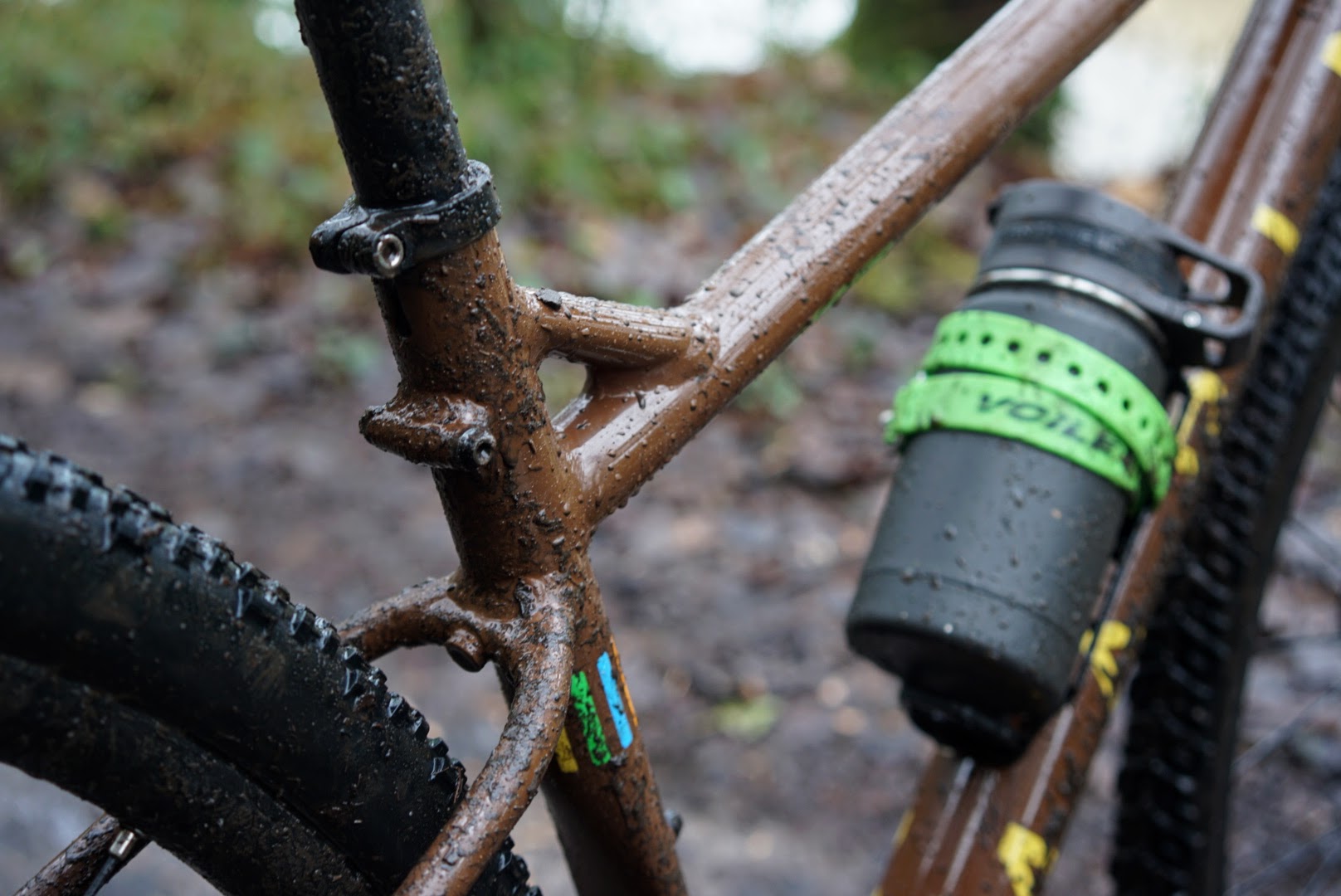
As the seat stays are dropped on the Marin DSX, rack mounts are added between the seat post collar and stays
On the subject of mounts, there’s also two sets of bottle cage mounts, one on the down tube and one on the seat tube.
One last thing: the frame takes Marin’s Number 44 rear derailleur hanger, which you can buy from their website for £20, the same as some of their 2020 Gestalt and Headlands models. Well worth having one of these spare with you if you’re planning on buying a DSX!
Groupset
The major difference between this higher tier model and the cheaper DSX 1, the DSX 2 features an almost entire Shimano Deore 12 speed groupset, first released in May 2020. The huge cassette is striking, ranging from 10-51 teeth, with a large Deore derailleur to accommodate this large range in gearing. This has been paired with an unbranded chainring and crankset, presumably to save cost, that comprises of a machined steel 42T chainring and cast alloy cranks, in either 170 mm length for sizes small and medium or 175 mm for the larger two sizes.
The large cut-outs on the narrow wide chainring certainly helps to make cleaning easier around the bottom bracket, which can be especially tricky. When thinking about this gear set up, I checked out the combination in comparison to a few other ‘known’ gears below.
Source: https://www.bikecalc.com/gear_inches, assuming 700c wheel size and 40 mm tyre
Gear inches = (# chainring teeth / # cassette teeth) x wheel diameter. By comparing these we can see how wide-ranging these different gearing set ups are in terms of their easiest and hardest gears.
| Deore 12spd 42 x 10-51 |
GRX 2X 31/48 x 11-36 |
GRX 1X 40 x 11-42 |
|
| Gear inches min | 22.66 | 23.77 | 26.26 |
| Gear inches max | 116.08 | 120.5 | 100.6 |
Remember that with the 12 speed set up you will need a 12 speed specific chain, like this one from KMC, which also means a new 12 speed quick link in your spares kit too. Don’t count on your pals having one with them if you’re running a different standard!
Moving on to the brakes, the bike is kitted out with Shimano MT201 brake levers and BR-UR300 flat mount hydraulic disc callipers, with Shimano 160 mm rotors front and rear. The brakes are good, complete with resin pads from new: of course not the most responsive and powerful you can find, but more than adequate for a budget-friendly build and for the tamer side of off-road riding.
If you’re used to MTB brakes, you’ll notice that these four finger brake levers are much longer than many modern designs, so you might want to move them inboard a little so you can brake effectively using just your index finger.
Wheels and tyres
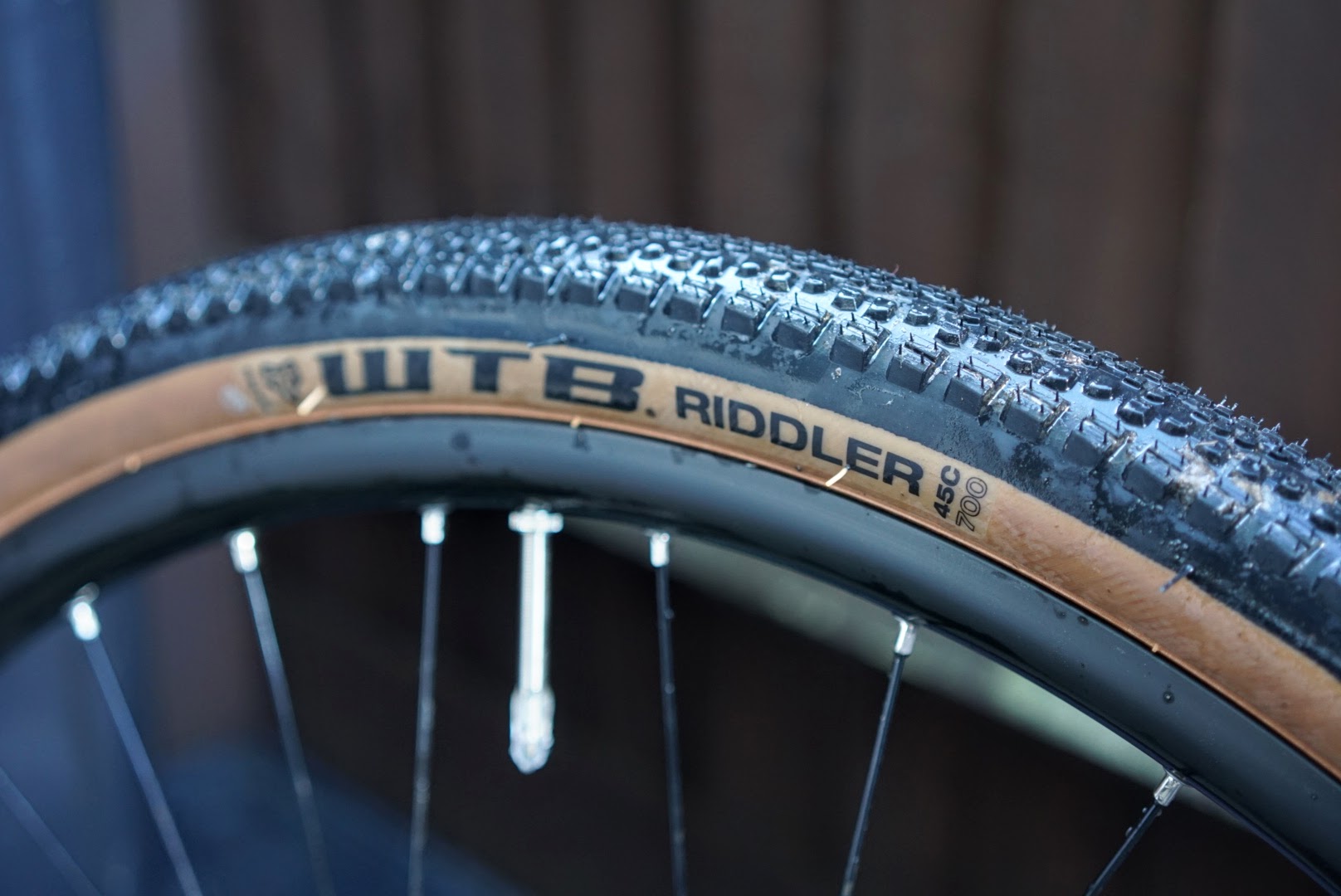
The WTB Riddlers are a good gravel tread for drier conditions, although the model supplied is not tubeless compatible
You’ll notice that in most of these pictures, I’ve switched out the box-fresh 700c x 45 mm WTB Riddler tyres for a set of my own 40 mm WTB Nanos, which were much more suitable for winter testing. I’ve always found the WTB Riddler to be a good gravel tyre, especially for dry, summer conditions, but when it comes to local riding in the wetter seasons, they just don’t have the grip that I need.
When set up on the stock rims, the WTB Riddlers come up at 40.5 mm (widest part, shoulder knob to knob), shy of the 45 mm claimed.

On the 21 mm internal Marin 700c rims, the WTB Riddlers come up a bit shy of the 45 mm stated at 40.5 mm
The wheels use Shimano alloy hubs: with the Shimano Micro Spline hub at the rear to accommodate the Deore 12 speed cassette. Marin have opted for a spoke count of 32 for strength and reliability laced to own-brand alloy disc rims.
These rims feature a 21 mm internal rim diameter, which is fairly standard for gravel builds and tyres: the same as the Shimano GRX wheelset, for example.
Unlike the cheaper DSX 1 model, the rims here are tubeless compatible, although you’ll need to replace the existing rim tape with tubeless tape before completing the conversion. The standard WTB Riddler tyres fitted aren’t tubeless compatible though, so you’d need to switch these out for the TCS model or other tyres for a tubeless set up.
I was a little surprised that Marin decided to build the DSX up on 700c wheels rather than opt for 650b with chunkier rubber for this more rowdy ‘gravel bike’, like the top tier Specialized Diverge Evo (although that’s over 2X the price at £2,600). On this size small, the wheels do look pretty huge! I suspect that this is a cost-saving exercise, as 700c is still very much the bike industry standard, even if 650b is gaining popularity for gravel riding.
Remember that if you’re looking to fit the DSX with smaller 650b wheels, you might need to source a new pair that are 12 speed compatible (Shimano Micro Spline) rather than simply swap in the pair you already have in the garage: at least for the rear!
Finishing kit

The central groove on the Marin saddle can collect mud in sloppy conditions, but is otherwise comfortable
Helping to keep costs low, but also with some considered design features, all of the finishing kit is Marin’s own, including the alloy seat post, seat post collar, saddle, bars, stem, grips and even stem cap!
I usually test a new bike for the first couple of rides with the stock saddle, replacing it thereafter with a model known to me if it’s not comfortable enough, but I have to say that I found the stock Marin DSX saddle just fine. Of course saddle fit is very personal, but the only faults that I could possibly find was black coating on the saddle rails wearing off quickly where it had been rubbed by my thigh, and how the muck collects in the recessed groove at the back of the saddle.
Up front, the cockpit is delightfully simple and clean. After a few months of MTB riding, the flat bars do seem really quite narrow, and on this size small measure up at 640 mm end to end, or 655 mm with the grips added. All other build sizes feature wider 680 mm bars. For comparison, I use 730 mm wide bars on my own ‘flat bar gravel’ conversion and 760 mm wide bars on my mountain bike, so you can easily see why these felt very narrow. I’d prefer it if they came wider to start so you could cut down if you wanted to, which is a fairly easy job to do.
Besides the bar width, it’s clear that Marin have done their homework when it comes to the shape of the bars. The number one issue I’ve seen when people convert from drop bars to flat bars is wrist pain due to the position on totally straight bars. This might be fine for pure trail mountain biking, where you’re actually moving around the bike a lot more and likely to be riding for shorter periods of time, but when you factor in longer rides, roads and gravel sections where you’re likely to be holding the same position it can become troubling. I for one have experienced this first hand!
Having a degree of sweep to the bars can help alleviate this, and goes towards why you often see ultra endurance mountain bikers racing with set-ups like Jones Bars, as an extreme example. Here, the Marin MiniRiser bar not only has 5 degrees of rise, but also a generous 9 degrees of sweep. Even after hours of riding on a mix of surfaces, I didn’t experience any wrist or shoulder pain, so these obviously do the job!
The bars have minimal branding, just like the alloy stem, which measures 70 mm across all sizes (with +7 degree angle for this small size). Marin’s own grips have are grippy without being too aggressive, with a wide, low profile flange giving a nod to MTB trend history.
Tech specs
Sizes: S, M, L, XL. For easy sizing and geometry comparison, visit GeometryGeeks.Bike (thank us later).
| Frame |
Series 3 DSX 6061 aluminium frame, tapered head tube, internal cable routing, with rack and mudguard mounts, two sets of bottle cage mounts and 142 x 12 mm thru-axle |
| Fork | Marin carbon fork wit a tapered steerer, 12 mm thru-axle and mid-blade mudguard eyelets |
| BB | Threaded Samox bottom bracket |
| Brakes | Shimano MT201 levers and UR300 flat mount hydraulic disc callipers, 160 mm rotors |
| Chainset |
Shimano Deore 6100 1 x 12 drivetrain with a 10-51 tooth cassette, black steel 42 tooth narrow/wide chainring with forged aluminium cranks, KMC X12 speed |
| Grips | Marin MTB |
| Handlebars | Marin MiniRiser alloy, 640 mm |
| Headset | FSA No.42 ACB, sealed cartridge bearings, 1 1/8” x 1 1/2” |
| Saddle | Marin DSX |
| Seat post | Marin alloy |
| Stem | Marin 3D forged alloy, 70 mm, +7 degrees |
| Tyres | WTB Riddler 700c x 45 mm |
| Wheels | 700c Marin aluminium disc rims, double wall with 21 mm internal rim diameter, 32 black stainless steel spokes laced on Shimano Microspline (12 speed) aluminium centrelock hubs, tubeless compatible rims, set up tubed |
The Marin DSX 2 verdict
I can’t deny that I was excited to hear that Marin were going to be producing a flat bar gravel bike this year, especially when I found out about the price tag, with the top model, the DSX 2, retailing at £1,095 ($1,149 €1,299).
With this in mind, testing becomes a little different than many of the gorgeous builds we’re fortunate to review here: the design focus is much more about making a great build within a price constraint.
Who’s it for?
During test rides, I asked myself, ‘who would buy this bike’? After a few months of testing, my conclusion is different to what I initially thought.
For sure, this is a fun bike, but I don’t think it would be the first choice for a seasoned off-road rider: more for a beginner cyclist or off-road rider who’s happier on flat bars than drops.
How did I come to this conclusion? Well, for a start it’s available as a full build only, which makes speccing your ideal componentry and build less straight-forward, although helps deliver greater value for the finished bike. If you’ve already got a set of wheels to upgrade with, for example, you’re unlikely to have a 12 speed compatible set as this bike is from the first year of 12 speed Shimano.
More strikingly, it’s just not different enough to a ‘standard’ gravel bike to warrant another bike for most. It hasn’t gone down the long-distance touring route with many mounts for racks, bags or even a third bottle under the down tube. Equally, it isn’t specced out of the box as a ‘monster cross’ type build, although it does have generous tyre clearance and routing for a dropper that would allow this.
Knowing that drop bars can be intimidating or off-putting for some entry-level riders, and that gravel riding has a growing reputation for being more welcoming and inclusive than road cycling – plus of course the traffic-free bonus – I think that the Marin DSX 2 would make a great bike for someone new to gravel riding.
The simplicity of 1X gearing adds to its suitability for beginner riders, both in terms of riding and maintenance. I certainly wish I’d had a gear set up this easy when I was starting out!
After spending the first few rides on the DSX pottering around town on errands, I also thought that it would make a pretty neat urban commuter! I guess it is a hybrid after all, eh?
Box build beauty
There’s something *really* satisfying about a box build: something that you just have to put together with a few basic moves and then you have a complete bike. Even better, when you don’t have to change anything at all.
Testing in the middle of (a very sloppy) winter meant that changing out the tyres was inevitable, so yes, I did swap out the Riddlers for some Nanos, but otherwise I didn’t have to change a thing, bar adding my own Shimano clipless pedals. If you don’t already have pedals, it’s worth noting that the DSX is supplied with basic platform flat pedals. The contact points were great: a minimal yet comfortable saddle for hours of pedalling and understated, palm-friendly grips.
The only thing I’d be tempted to change would be the width of the bars, although that’s most likely a personal preference due to riding wider bars on other bikes. If I was new to riding, I’d not know any different!
Sized up and weighed
I had the size small on test, the smallest of the four sizes on offer. This fitted well with no discomfort, although if anything was a fraction too small. For reference, I stand at 5ft5. That made a really great change, as usually I’m disappointed by how few frames size down well to accommodate shorter riders.
I was also pleasantly surprised that even with this tiny frame and 700c wagon wheels there was no toe overlap, which would be in part thanks to the relatively slack 69.5 degree head tube angle.
The complete bike, without pedals or bottle cages came in at 10.95 kg. Not the lightest nor noticeably hefty to ride, although when you pick the bike up, it is certainly much heavier towards the back with the weight of the Deore cassette, which is over half a kilogram alone.
On the whole, I think that this is a corking bike for the price, thoughtfully put together with room for some home upgrades too. Hopefully reasonably priced, yet still very capable bikes like this will be a catalyst for more riders trying out gravel riding as an entry point to cycling.
Call it whatever you like, but there’s no denying that this little bike is a lot of fun.
Last modified: 28th January 2021

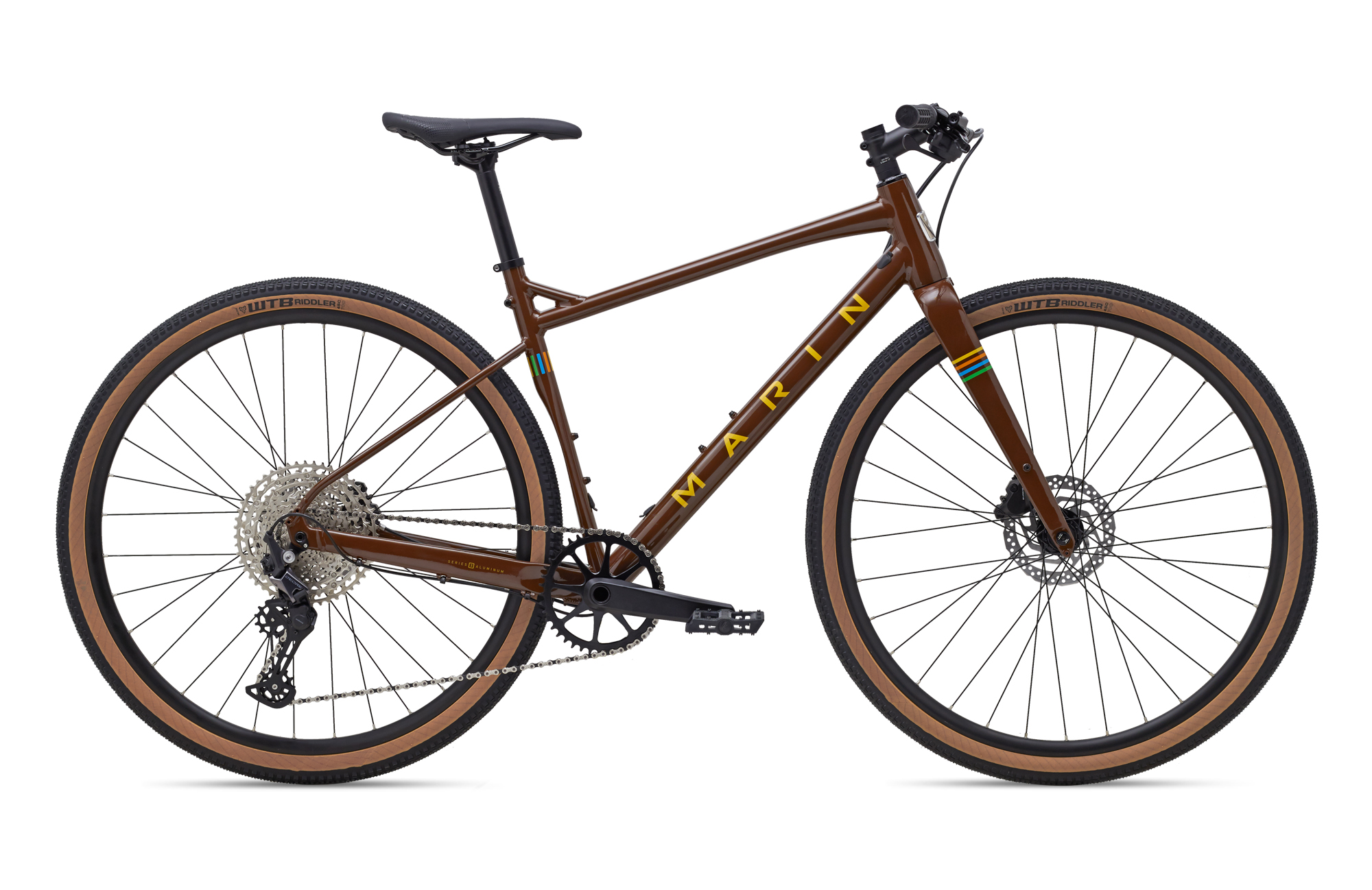

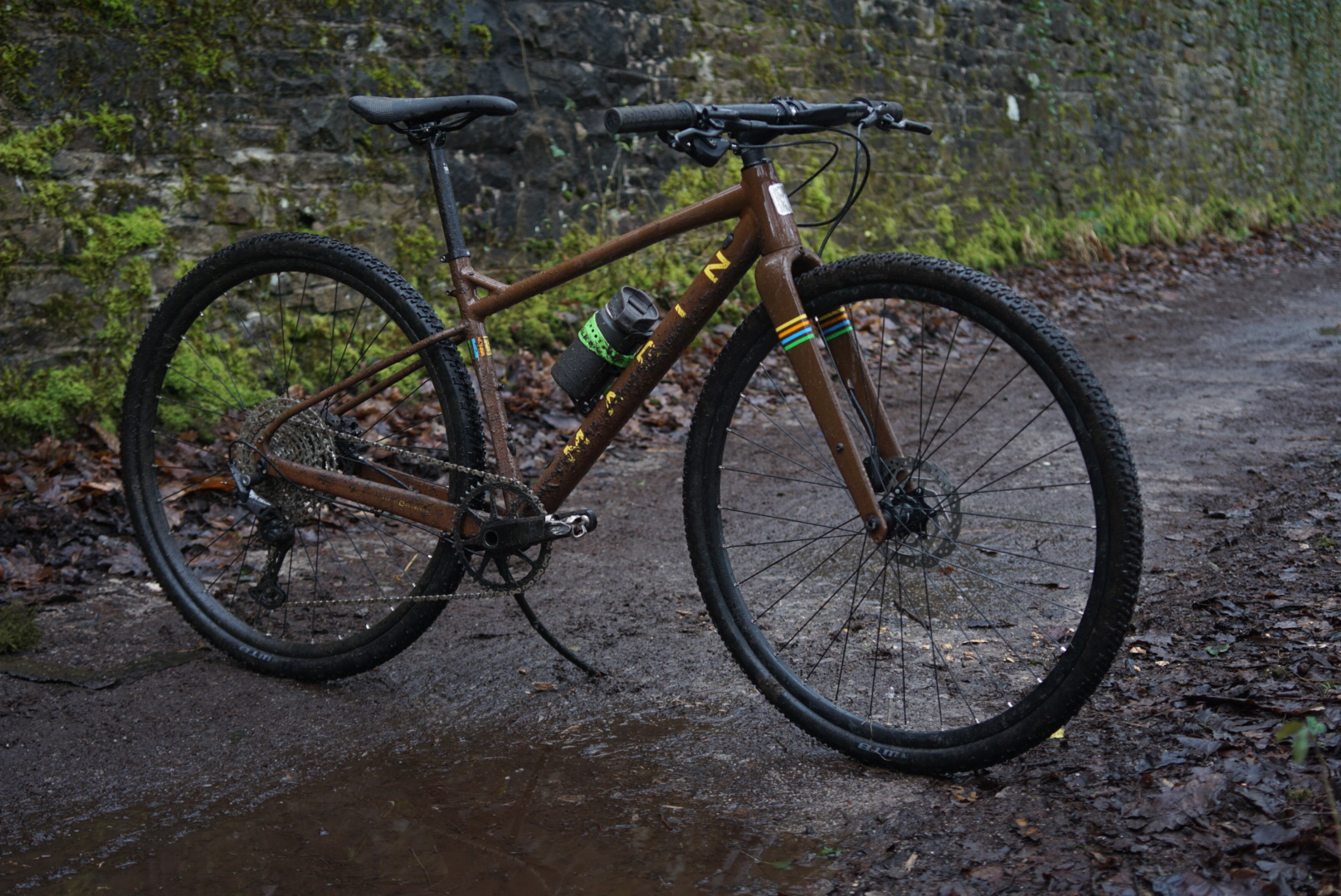


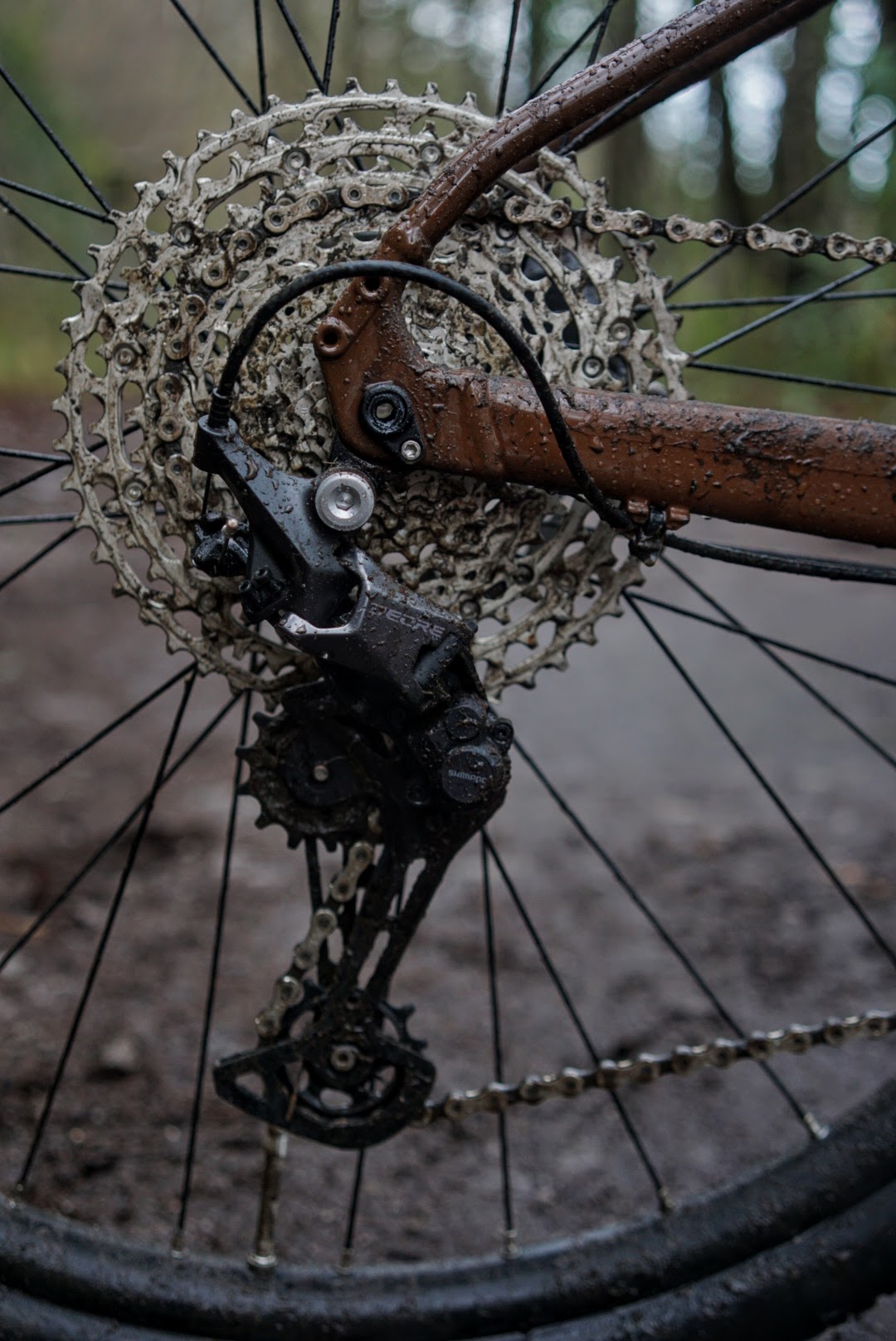

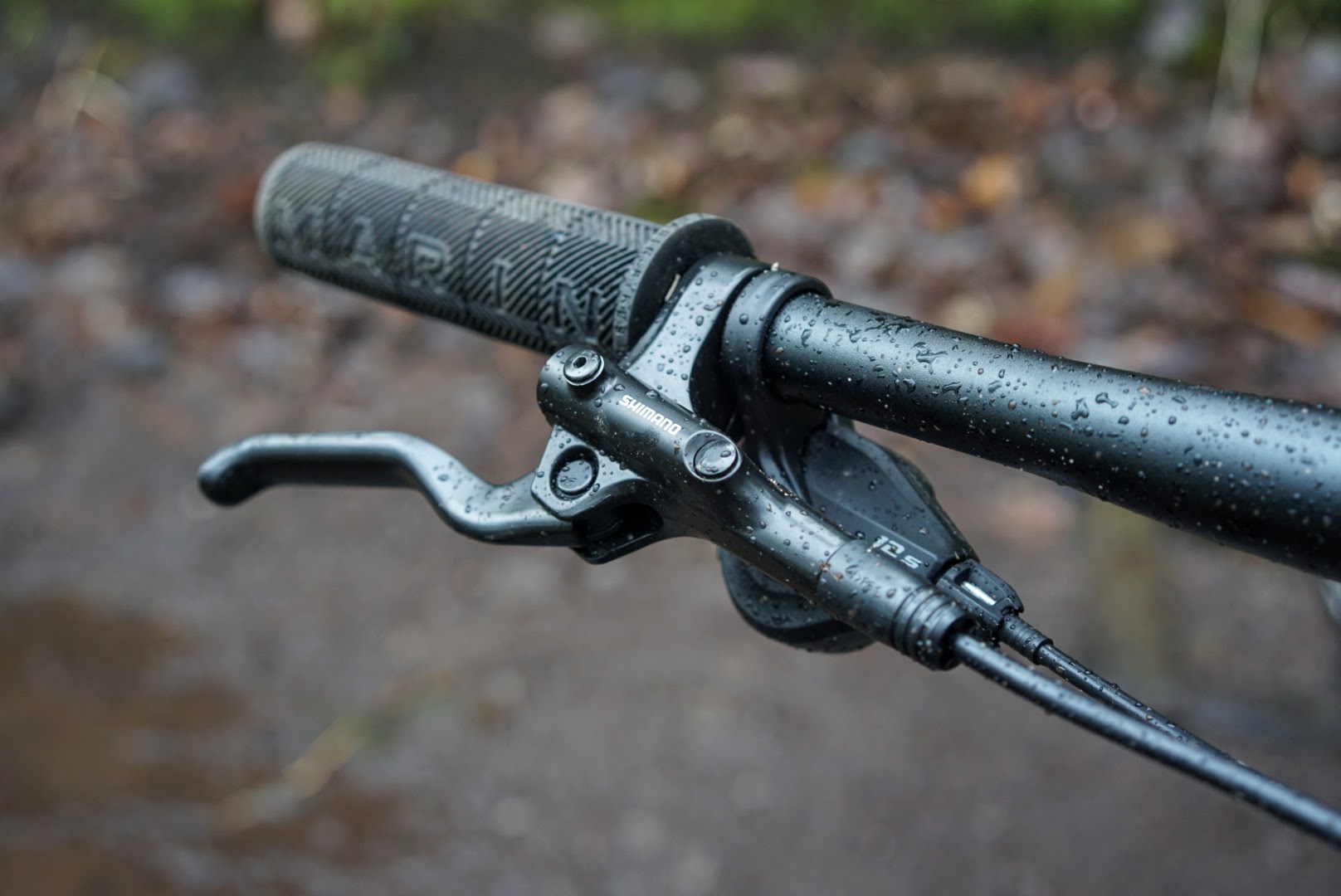
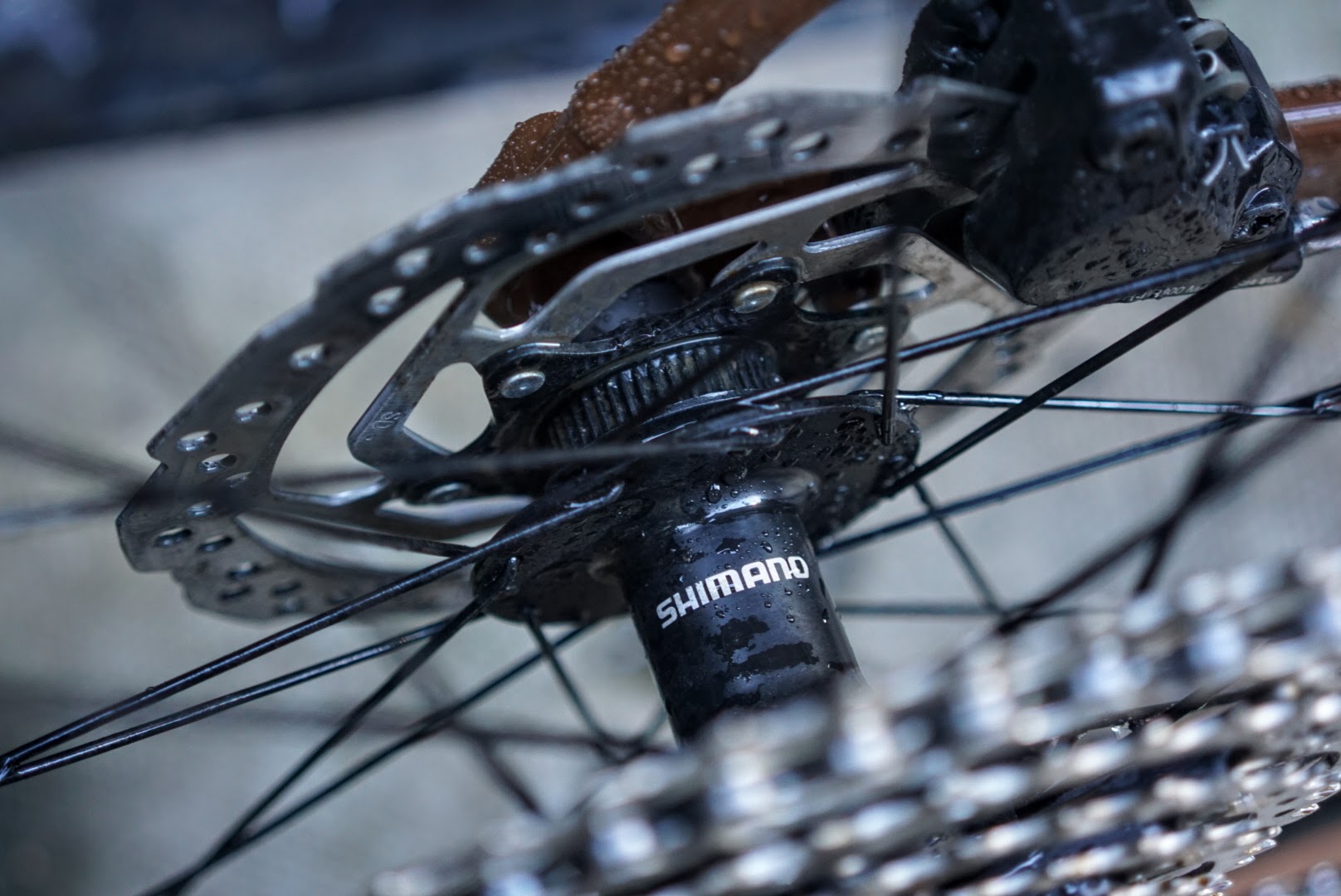
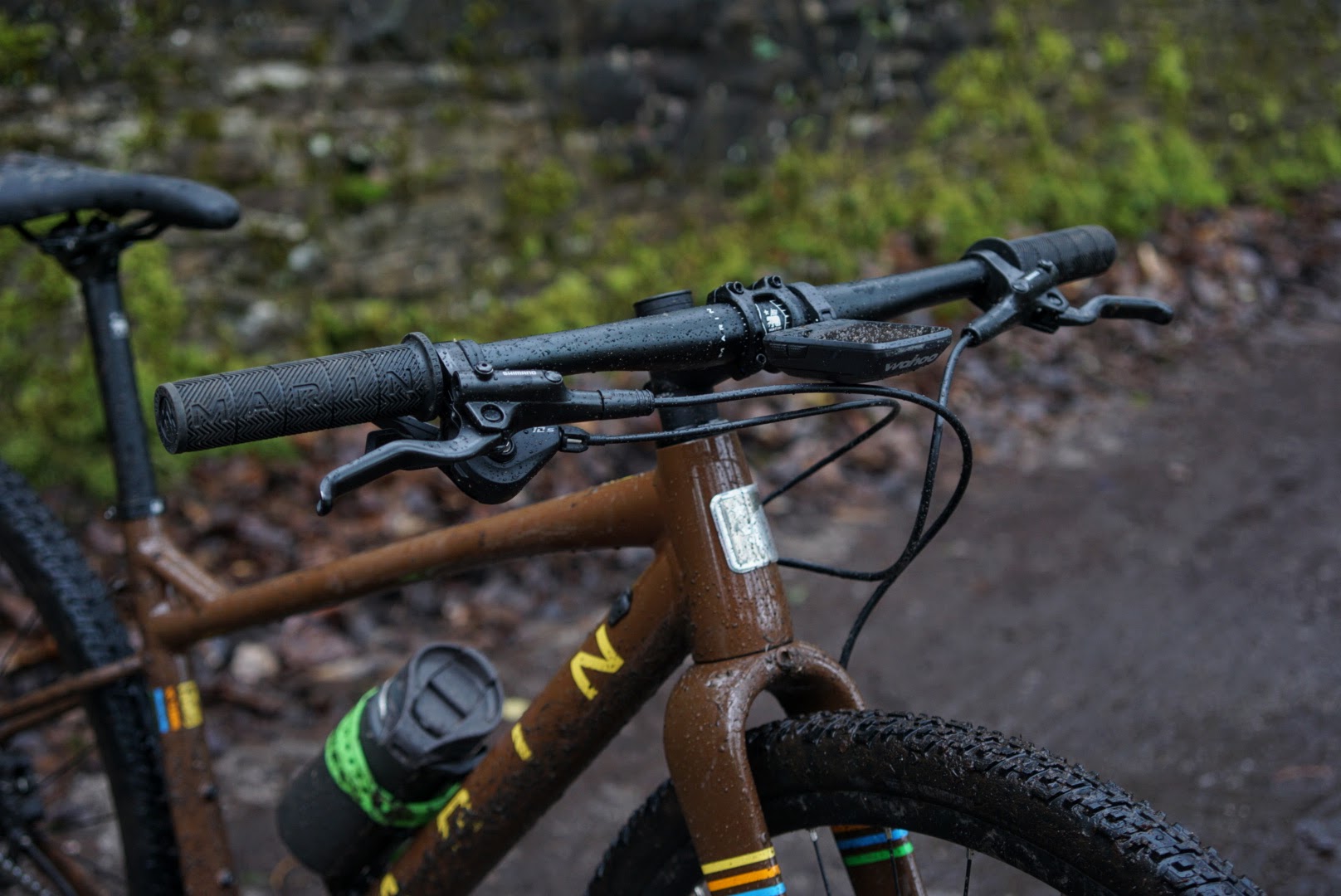


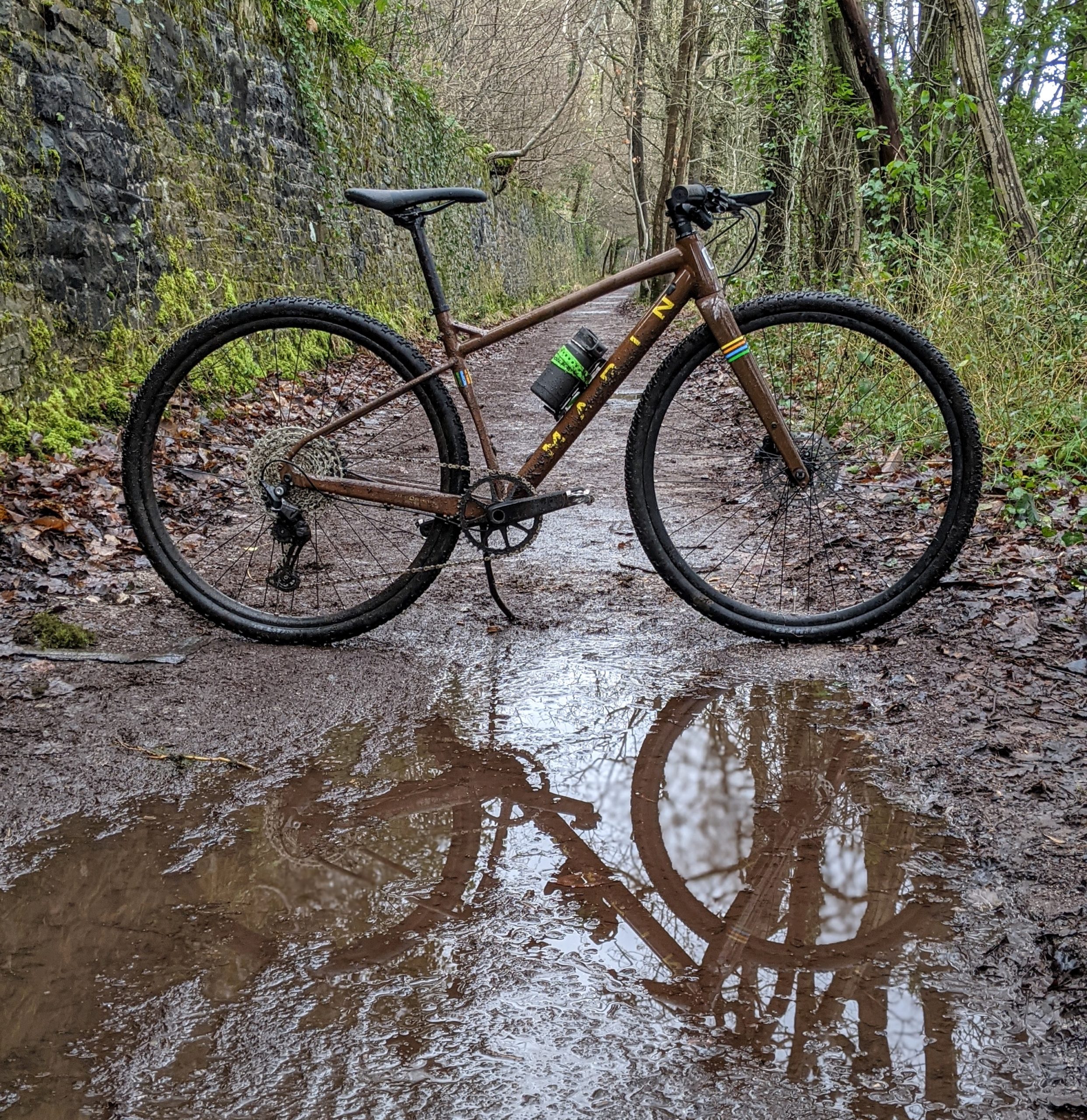
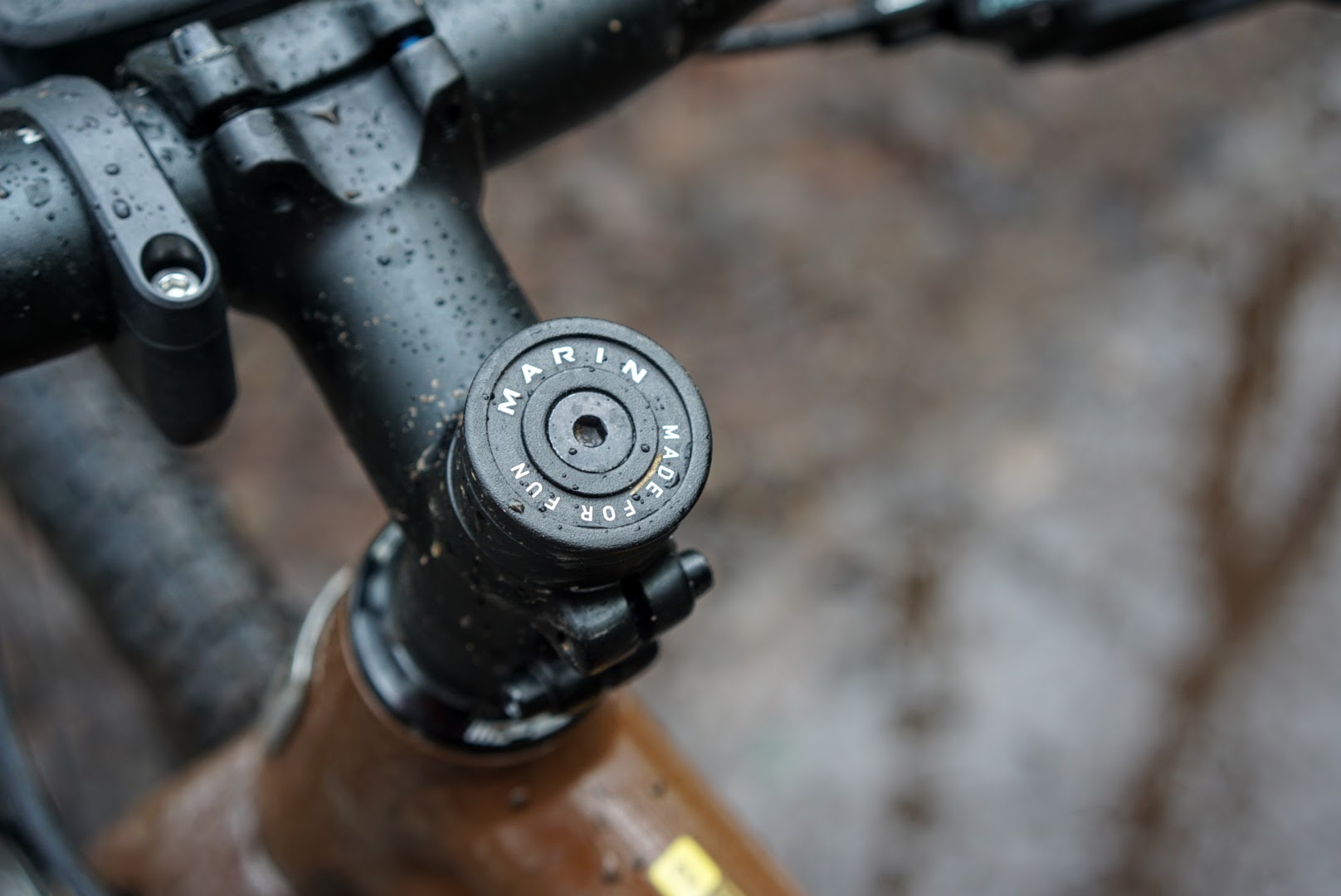
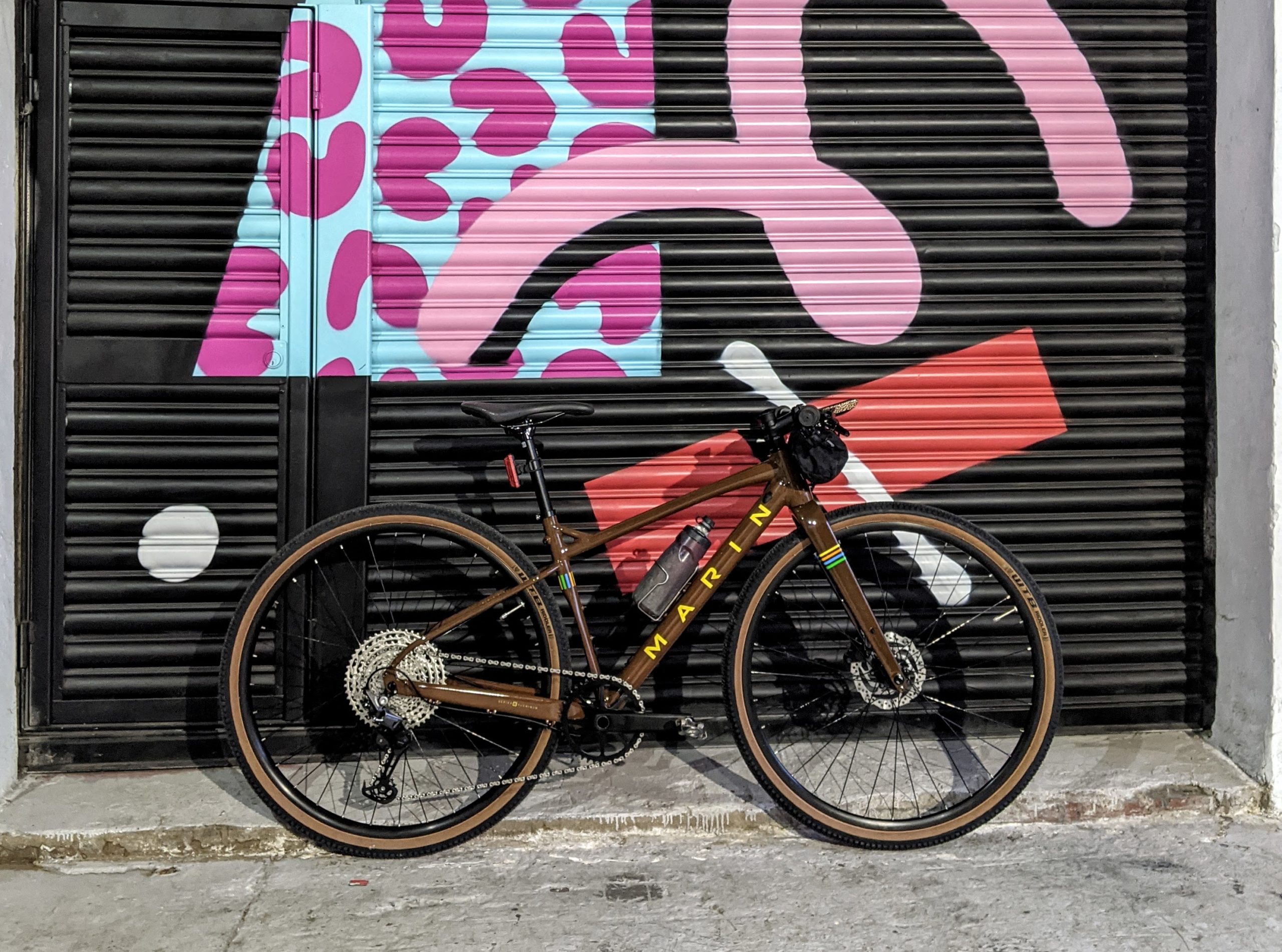












I recall when the Specialized Sirrus X came out, and it was so much better to ride than 90% of the hybrid bikes on the market, but I wanted room for bigger tires, and a slacker front end. Nice work, Marin!
Great review, thanks. I’ve got this bike as my new all rounder and am very pleased with it.
Glad to hear it! It’s impressive how versatile it is, eh?
Great review. I’ve just bought the DSX 1. It’s a cracking bike for the price. 2 points – I really don’t like the front axle separate nut, it seems like it creates more problems than it solves and I can see that being easily lost during a trailside repair. Secondly, are the rims on the 1 definitely not timeless ready? That seems a strange omission for a bike that is properly sorted everywhere else. Other than that, it really is great and the off white colour is awesome
On the tubeless ready query – from what Marin tell us, only the rims on the DSX 2 are tubeless compatible, I expect this would be a cost saving measure on the cheaper DSX 1. Glad you’re stoked on your new bike!
But how are the rims different? On Marin website they are bot Marin Aluminum Double Wall, 21mm Inner, Disc Specific rims. On wheels, the only difference is hubs, and they do come with none tubeless tires.
Afraid I can’t answer that, only that my contact at Marin confirmed that the DSX 2 is tubeless compatible and the DSX 1 is not. They can still both be different rims with the same specs in those regards.
I emailed them and this was their reply:
Hello and thanks for your reply and support of Marin Bikes,
Greetings from Northern California! Unfortunately the DSX 1 and 2’s rims, tires and rim strips are NOT tubeless compatible:
Thanks and please feel free to email back with any questions,
Gravy
Technical service / Team mechanic
Interesting… there’s a difference between tubeless compatibility and being tubeless ready (tubeless tape installed as supplied). Who knows, sounds like you might be able to set them up tubeless after all!
I have a DSX1 and have about 150 miles on it after setting up tubeless. The tires are a bit big for the rims, so while one seated instantly, the other required and extra layer of tape to get it to move onto the bead. Once it popped though, no issues, and they’re not leaking air. Used Stans sealant, WTB tape, and a compressor to set it up.
What size WTB tape?
Do you think going a frame size up would be too long for using the aero position on the Jones bars?
I think a slightly longer stem would probably work better. I like the bike for what it is, I think if I’d have gone up a size I’d probably lose a little of it’s all round ability ie a gravel bike, a rigid MTB, a “hop on” bike – I like that it does everything. I’ve struggled with neck pain when using drops, but this bike with the Jones bars hasn’t caused any discomfort
Wow, the first full review! Great!
The main question – what about sizing and fittin’? This bike has it’s own special geometry and is positioned as “the mountain biker’s gravel bike with familiar hand positioning”, but it’s ETT and reach are nearly 15-20 mm (0,4-0,7″) shorter than usual recommended MTB frame. Stack is also much lower.
For examle, I’m 5ft 9″ (175 cm) high, I usually go for M size MTB’s with ETT from 585 to 600 mm. Marin also recommends me an M size, but I’m abit afraid of it could be little shorty for me.
I’m 5’8 and have the medium. I wouldn’t want it any smaller. I haven’t had much time on it yet but it’s not the longest top tube. In fact, I’ve fitted my jones bars and find it very comfortable now
Tht’s what I’m afraid – that M size would be very short for me. My position would be very very upright.
I think this bike with an alt bar seems almost a perfect do it all, long tourer. MTB gear range with large chainring on fairly large 700 tires, are there even any other bike options with these specs? I’ve looked but can’t find anything.
Breezer Thunder is another great option that’s more on the mtb & touring vs gravel side. But, like all other bikes these days, out of stock everywhere.
Glad to see the ‘bike industry’ is devolving to 1985, I started mountain biking in…. Marin County. This bike seems like an updated version of what was called a mountain bike back then but was basically a “do everything” bike. This looks like a great option for trails, city riding, and just tooling along enjoying the scenery. I’m considering one but would love to see a front rack mount for ultimate versatility And kudos to Marin for keeping the price sane.
Hello. Your review is helping me decide on the size of DSX to get. I’m caught between the small and medium size. I’m standing 5’5″ and wanting to get the Medium but only the Small size is available. My question is.. Are you okay with the geometry of the Small frame? Is it comfortable for long rides? (150km). tia
Heya Kenneth. I’m 5ft4 and to be honest, I was really at the upper end of this size small, obviously different dimensions might come into play, but sounds like you might need the medium. Unfortunately due to lockdown restrictions I was unable to test for that ride duration, but the bike was more than comfortable for me for shorter rides. Hope that helps – waiting for the right size is always the best thing to do in the long run!
Fellow shorty here, also 5’5” (30 inside leg or so). I emailed Marin uk about availability (a few mints for medium) and sizing. This was their response
“The Small DSX is very Small, you are on the edge of both sizes but I would suggest the Medium would be ok. Obviously it is always best to try before hand.”
What size did you go for in the end? I’m thinking medium, also 5’5”
I have a Marin DSX 2 on order and would like to change the stock 42t chainring to a 36t chainring. What kind of chainring would be compatible with the bike? As far as I can tell it has a direct mount system and the cranks are unbranded, but I really can’t find any more info than that.
Hi there! Thought I’d help out. Here is a picture of the direct mount interface on the stock chainring of the Marin DSX 2. I don’t know what system it is but maybe the picture helps?
The reason I have this is I changed the crank on my bike to the Shimano GRX 600 crank with a Wolftooth 38t chainring. Wolftooth also has a 36t that would work. I recommend changing the crank as I saved around 400g with the change.
edit: image not attaching, here is a link: https://imgur.com/a/sKl1itt
How much does the original crank w/chainring weight? Did you change BB?
The original DSX-2 crankset with chain ring is 1001 g. For comparison, I replaced it with a Shimano XT crankset with a 32 tooth chainring that weighed 671 g.
Hi there!
Thanks very much for the review. I’m in love with this bike but I’m quite tall (198 cm). Do you think there’s any sense in trying the XL size or should I look for alternatives? And if so, what could be a good alternative?
Thank you,
Douwe
Hmm, probably a question best directed at Marin about sizing. Thanks and good luck!
Surprising to see the measurement you got from the tyres. I just received a DSX 2 and the tyres (the same WTB Riddlers in 700x45c) measure 47.7mm across at 60 psi.
Crikey!
It will be 2 yrs in June 22 that I’ve had my Marin DSX 2. I mainly ride it on rails to trails bike paths, some played some not. And, I dont ride near as much as I’d like to. Anyway, I recently had issues with the front bearings. Had them looked at and greased before finishing my ride and was told front and back need a good cleaning and repacked with grease. I did not expect this to be an issue so soon. Had my $500 specialized bike for 6 years and never had that problem.